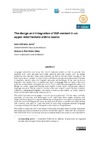Identificador persistente para citar o vincular este elemento:
https://accedacris.ulpgc.es/handle/10553/70339
| Campo DC | Valor | idioma |
|---|---|---|
| dc.contributor.author | Gimeno Sanz, Ana | en_US |
| dc.contributor.author | Martínez Sáez, Antonio | en_US |
| dc.date.accessioned | 2020-02-19T07:18:52Z | - |
| dc.date.available | 2020-02-19T07:18:52Z | - |
| dc.date.issued | 2016 | en_US |
| dc.identifier.issn | 1133-1127 | en_US |
| dc.identifier.uri | https://accedacris.ulpgc.es/handle/10553/70339 | - |
| dc.description.abstract | Language instructors who adopt the role of materials writers in order to provide their students with more accurate tailor-made learning resources usually start by closely examining their learners’ needs and demands, as well as the distinctive features of the teaching context or situation in which those materials are going to be implemented. This idea is especially relevant when the linguistic resources are developed to be used by future engineers who access them to practice and learn a language that will have a dominant presence in their future working environment. This is a fact that encouraged the authors to design an online upper-intermediate level English course which incorporates relevant language resources directly linked to the disciplines and content covered by their students’ university undergraduate degrees. The course is known as the InGenio FCE Online Course & Tester (Universitat Politècnica de València, 2011). The article illustrates how language instructors try to explore and find new ways, methods, typologies of exercises, and techniques which might help them create, promote, and implement learning systems capable of fostering an integral communicative competence and make the entire learning process more dynamic and attractive. A specific case study dealing with students who seek to make the most of combining Computer-Assisted Language Learning and English for Specific Purposes is described and analysed here. The reader is presented with a description of the steps that were taken to design innovative and engaging online courseware to cater for the learners’ specific needs and the conclusions that have arisen from conducting a survey to analyse student perceptions and expectations prior to and after completing the said online course. | en_US |
| dc.language | eng | en_US |
| dc.relation.ispartof | LFE. Revista de Lenguas para Fines Específicos | en_US |
| dc.source | LFE. Revista de lenguas para fines específicos [eISSN 2340-8561], v. 22 (1), p. 31-53 | en_US |
| dc.subject | 570107 Lengua y literatura | en_US |
| dc.subject | 550510 Filología | en_US |
| dc.subject.other | ESP content | en_US |
| dc.subject.other | Online language learning | en_US |
| dc.subject.other | Courseware design | en_US |
| dc.subject.other | InGenio authoring tool | en_US |
| dc.subject.other | Learner satisfaction | en_US |
| dc.title | The design and integration of ESP content in an upper-intermediate online course | en_US |
| dc.type | info:eu-repo/semantics/article | en_US |
| dc.type | Article | en_US |
| dc.identifier.doi | 10.20420/rlfe.2016.0089 | en_US |
| dc.investigacion | Artes y Humanidades | en_US |
| dc.type2 | Artículo | en_US |
| dc.identifier.ulpgc | Sí | es |
| dc.description.esci | ESCI | |
| dc.description.dialnetimpact | 0,0 | |
| dc.description.dialnetq | Q1 | |
| dc.description.dialnetd | D3 | |
| dc.description.erihplus | ERIH PLUS | |
| item.fulltext | Con texto completo | - |
| item.grantfulltext | open | - |
| Colección: | Artículos | |
Citas de WEB OF SCIENCETM
Citations
2
actualizado el 08-jun-2025
Visitas
36
actualizado el 02-mar-2024
Descargas
51
actualizado el 02-mar-2024
Google ScholarTM
Verifica
Altmetric
Comparte
Exporta metadatos
Los elementos en ULPGC accedaCRIS están protegidos por derechos de autor con todos los derechos reservados, a menos que se indique lo contrario.
